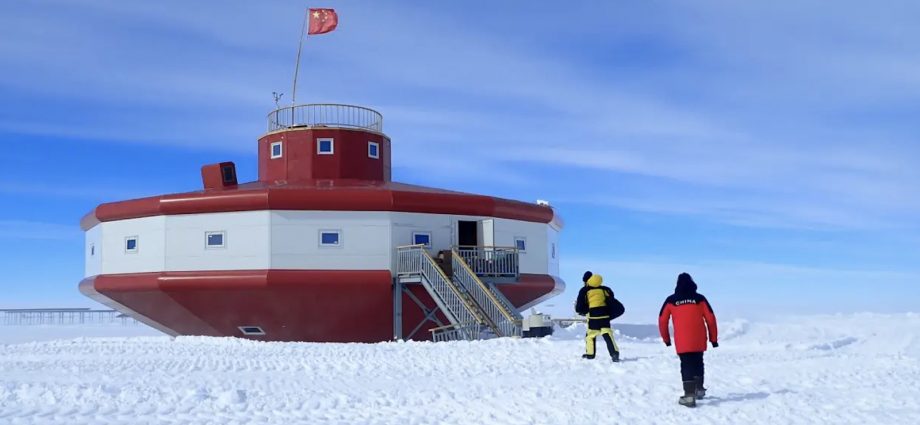China Aerospace Science and Industry Corporation (CASIC) had been selected to build a new ground station in Antarctica to serve China’s National Satellite Ocean Application Service (NSOAS).
Such news, reported on February 2, might have ordinarily set off alarm bells in Washington, but the Americans were too busy watching the large Chinese spy balloon drift above North America.
Since 2002, China has launched eight ocean observation satellites into orbit for various purposes including oceanographic analysis, resource exploitation, the study of coastal ecology and disaster monitoring. A ninth is scheduled to be launched this year. The new Antarctica ground station will facilitate the transmission of data from these satellites.
The new antennas and receiving terminal will be built at China’s Zhongshan scientific research base, also called a “station,” which is located in East Antarctica near Prydz Bay, facing the Indian Ocean. Zhongshan is one of five Antarctic research stations managed by the Polar Research Institute of China. In order of establishment, they are:
- Great Wall Station (1985), King George Island, South Shetland Islands
- Zhongshan Station (1989), Princess Elizabeth Land, East Antarctica
- Kunlun Station (2009), Princess Elizabeth Land, East Antarctica
- Taishan Station (2014), Princess Elizabeth Land, East Antarctica
- 5th Antarctic Station (working name: Victoria Land Permanent Base) (2022), Inexpressible Island, Ross Sea
Inexpressible Island was named for the inexpressibly miserable winter spent there by members of Robert Falcon Scott’s Terra Nova Expedition in 1912.
Zhongshan, Kunlun and Taishan are located in the Australian Antarctic Territory, which occupies about 42% of the continent. Inexpressible Island is located in New Zealand’s Ross Dependency, which includes the entire Ross Sea, including most of the Ross Ice Shelf and bordering coastal and inland territories in a wedge running to the pole.
Chile, Argentina, Norway, the UK and France also claim Antarctic territory. But none of these claims are recognized under the Antarctic Treaty, which all of them, as well as the US, China, Russia and 45 other countries, have signed. Twelve countries have research stations on King George Island.

Article IV of the Antarctic Treaty reads:
No acts or activities taking place while the present Treaty is in force shall constitute a basis for asserting, supporting or denying a claim to territorial sovereignty in Antarctica or create any rights of sovereignty in Antarctica. No new claim, or enlargement of an existing claim to territorial sovereignty in Antarctica shall be asserted while the present Treaty is in force.”
Of equal importance, Article I states that:
- Antarctica shall be used for peaceful purposes only. There shall be prohibited, inter alia, any measures of a military nature, such as the establishment of military bases and fortifications, the carrying out of military maneuvers, as well as the testing of any type of weapons.
(2) The present Treaty shall not prevent the use of military personnel or equipment for scientific research or for any other peaceful purpose.
There’s the geopolitical rub. Military personnel and equipment used for peaceful purposes today could be used for other purposes tomorrow. As Anthony Bergen of the Australian Strategic Policy Institute (ASPI) pointed out in an essay published in April 2020, the interpretation of this provision “has never been tested…but could be tested over time.”
And, “Given the track record Beijing has in moving rapidly on a broad front, as it’s done in the South China Sea, we need to be prepared to respond to a rapid increase in the speed and scale of China’s actions in Antarctica.”
He adds that “Some academics point out that Antarctica could be useful for various command, control, surveillance and reconnaissance systems, as well as for basing satellite receiving and processing stations.”
Due to the extreme logistical challenges, military aircraft, naval vessels and satellite communications are essential to the Antarctic research activities of Australia, New Zealand, the US, the UK and other countries including China.
It should also be noted that China’s primary logistics base for activities in Antarctica is located in Hobart, Tasmania.
In an earlier report published by ASPI in August 2017, Professor Anne-Marie Brady of the University of Canterbury, Christchurch, New Zealand, wrote that “China has conducted undeclared military activities in Antarctica, is building up a case for a territorial claim and is engaging in minerals exploration there.”
The Center for Strategic and International Studies (CSIS), a Washington-based think tank, concluded in an October 2022 report that:
“The PLA’s prominence within China’s domestic space industry has flamed fears that its influence extends to overseas ground stations dotted across the globe. Ground stations form a key terrestrial leg of China’s overall space infrastructure, fulfilling the telemetry, tracking and command (TT&C) responsibilities that enable the operation of satellites and other spacecraft.”
“Ground stations also help keep track of the tens of thousands of satellites and other objects in Earth’s orbit—a capability known as space situational awareness (SSA) that is critical for fighting and winning wars in information-rich battle spaces.”

Until 2020, China had access to ground stations in Australia, Chile and Sweden under long-term contracts with the Sweden Space Corporation. According to the corporation’s spokesperson, those contracts were not renewed due to changes in the geopolitical situation.
China has in any case been building its own extensive network of satellite ground stations around the world. In South America alone, it has 11 stations – two in Venezuela, three in Bolivia, one in Chile, one in Brazil and four in Argentina. Aside from Chile, these countries are at geopolitical odds with the US.
China reportedly plans to launch more than 200 satellites this year. How they will track and communicate with them is likely to remain a high-priority topic for Western strategists and spies.
Follow this writer on Twitter: @ScottFo83517667

